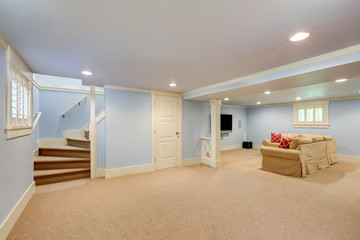Construction has been around for a long time and it is gaining more importance as modern-day living conditions change. The main reason for basement construction is to improve homes in terms of space, whilst also providing an extra room for recreational purposes. This article will concentrate on the construction of basements for residential purposes. Basement construction involves many aspects and it is not something that should be attempted by amateurs. Therefore you must contact a professional basement construction company to carry out the work for you, as they are more skilled and experienced than your own skills.

Basements normally require careful planning for the interior environment to achieve the right degree of waterproofing required. There are basically three types of basement construction. They are concrete, poured concrete and pre-cast concrete, all with their own pros and cons. All have the potential to cause problems with moisture and water leaks if not designed correctly, so you must employ the services of a competent and experienced basement contractor who will ensure your basement meets all regulations and is waterproof. A good basement contractor will be fully aware of all the issues involved and will be able to recommend a course of action to resolve the issue.
Most people prefer the use of basement construction for living areas. You will often find that basements are often positioned above ground level, which means that there is no need to open up the ground floor to install drainage systems and other features. This is especially true of wet basements which are frequently situated below the surface level of the earth. Many homes are nowadays constructed with an attached garage. In this case, the garage will often receive extra moisture which will cause dampness in the living area.
Damp basements can pose several problems, so it is paramount that your basement construction specialist includes provisions for new home plumbing as part of the design. The likelihood of your new home having a high water table is very likely, so regular checks are necessary to ensure your plumbing system does not suffer from leaks. If you live in an area that experiences high water tables then you should always hire a qualified plumber to carry out any necessary maintenance work. If your home is not situated on a high water table then it may be more economical to dig a hole in the ground and install a sump pump or submersible well. Once your home has a sufficient water level then you should be able to pour waterproof concrete cracks in place to prevent water from entering your basement.
Basement construction and design will also incorporate the installation of adequate insulation. A great insulating factor for basements is the fact that they tend to be located below grade. Consequently, this will lead to the absorption of thermal mass, as well as airborne contaminants such as pollen and dust mites. A great strategy to combat the infiltration of these allergens is to install barriers of insulation in strategic locations such as around roof openings, floor joists, and brick ledges. The use of insulation is very important for basements as they can effectively trap heat in the summer and keep it out in the winter. Proper insulation can also aid in reducing energy bills.
Drainage systems are another crucial component of basement construction and design. There are numerous options available when it comes to waterproofing systems such as sump pumps, pipe ventilation, and French drains. It is important to ensure that you follow the appropriate guidelines when it comes to selecting the right system for your property. Although most drainage systems can be installed by amateurs, it is inadvisable to attempt to install without the assistance of a professional. Failure to waterproof your basement properly can result in serious problems such as water damage, mold growth, and leaks.
Another option that many people prefer when it comes to constructing a poured concrete basement is the incorporation of prefabricated footings. Footings are often made of rebar or metal and are then poured onto the floor of your basement. Prefabricated footings provide a level of durability and safety that can’t be achieved by using natural footing materials. In addition to being extremely durable, prefabricated footings are also designed to match the color and design of the poured concrete basement floor.
There are other ways in which you can waterproof your home as well. For instance, many homeowners opt to build their own waterproofing systems such as French drains and block basements. A water-proofing system may consist of a series of basins that are installed along the exterior of your home. Block basements are another option, which involves building an interior foundation and then planting large trees on the outside perimeter of the foundation to create an artificial lake.